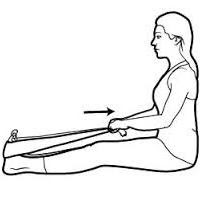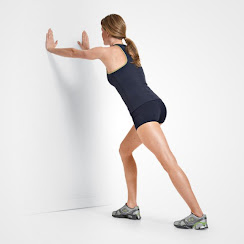 |
| Pull in Calf muscle |
What is a pull in calf muscle?
A pull in calf muscle is also called calf muscle strain, it occurs when the muscles in the calf (the soleus and gastrocnemius) get overstretched during performing any activity of leg.
The calf muscles are located in the lower leg behind the shin bone and extend from the base of the thigh down to the heel. They work as flex and bend the foot, ankle, and knee. A calf strain can cause pain and make difficulty to perform running, jumping, and doing other activities.
A pull in calf muscle can result in partial tear or complete tears depends upon level of injury. A torn calf muscle may require surgery to repair it.
What is the difference between muscle strain or muscle pull or a sprain?
Pull in Calf muscle also you can say A calf strain but it isn’t a sprain. Strains mean injuries to muscles or tendons (tissues that attach muscles to bones) while Sprains occurs injuries to ligaments (tissue that connects bones or cartilages or holds a joint along).
Where is the calf muscle located?
The calf muscle is a group of two main muscles — the gastrocnemius muscle, the soleus muscle and additionally plantaris muscle.
These two muscles the gastrocnemius and soleus muscles are collectively big muscles with two sections.
a small muscle called the plantaris travels between the gastrocnemius and soleus muscle throughout the length of the lower leg. these 3 muscles are also called the triceps surae. however, not everyone have a plantaris muscle. Mostly 100 % of individuals have 2 larger muscles.
Gastrocnemius Muscle is the larger Calf Muscle Forming The bulge of Muscle mass and visible beneath the skin. Gastrocnemius has 2 heads which looks like Diamond shape.
The Soleus Muscle is a Small Muscle, Flatt and located underneath The Gastrocnemius Muscle.
A majority of soleus muscle fibers originate from each side of the anterior aponeurosis, attached to the tibia and fibula.
Insertion:
Both Muscle Insertion merge via Tendo Achiilis and the Achilles tendon inserts into the heel bon(calcaneus).
Action:
Calf Muscle is one of strong lower limb Muscle which Planter Flex from Ankle Joint.
This muscle is anti-gravity Muscle and normally all anti gravity Muscle require high Power that's Why All anti gravity Muscles are Bulky and Strong.
Running, Jumping, Dancing, Cycling all this Activity uses Calf Muscle.
Jumping is the activity where Highest uses Calf Muscle.
Who gets Pull in Calf muscle?
Anyone can have a pull in calf muscle. But these pull are most commonly seen in sports person who perform lots of stop-and-go movements with jerky bursts at ankle such as Sprinters, football players, Hockey players, soccer players, and tennis players are at risk of calf muscles strain. eventually, the injury is also called “tennis leg.”
What is the causes of pull in calf muscles?
Call muscle pull mostly occur when someone suddenly moves or overstretches in the calf muscle during moving or playing activity such as Fast pivots, jumps, or abrupt stops can cause muscle strains. This injury is mainly common when ankle get forced upward (toward the body) and the ankle stretches the calf muscles down too rapidly.
Following are the most common cause of calf muscle pull, these are:
- Not warming up correctly before sports or physical activity
- Calf Muscle tightness (deficient flexibility)
- Calf muscle weakness (deficient conditioning)
- Overexercise or Over physical activity (Overexertion and fatigue)
Acute calf muscle pull occurs during Slip body, jump, run, throw something, raise something heavy, lift something while clumsy position.
Chronic calf muscle pull occurs during Sports like row, playing Hockey, tennis, golf, or baseball, poor posture, holding back or neck in an ungainly position for long periods of time, like after work at a desk.
Overuse:
Repeated ankle movement can lead to microtrauma of calf muscle will cause overuse calf muscle pull.
Don’t stretch or warm up prior to exercise: Stretching prior to calf exercise step by step will increase how much stress you place on muscles.
Calf muscle tightness: If your calf muscles are tight and not flexible to high intensity activity in full range then your calf muscles (and the fibers in them) are tighter, which build them additional risk to strains.
Other risk factors for calf muscles pull are:
Age: People over 40 may be more likely to have muscle strains during physical activity.
Sex: Men are more likely to get calf muscle pull as compared to females.
Calf muscle weakness: It’s important to do warm up and stretch your calf prior to any physical activity and condition muscles before the start of a sports activity.
The Calf muscle pull is classified into three grades:
Grade 1: It is the type of muscle strain that occurs once a overstretch causes very few micro-tears among the muscle fibers. It could also be ready to resume an activity without pain or with gentle discomfort. Mostly post activity tightness and aching, Full recovery take within 1 weeks. average time to return to sport 10-12 days. sign-pain on unilateral calf raise or hop.
Grade 2: This strain include a partial tear of the muscle fibers. you may acquire to limit activity, but full recovery takes around five to eight weeks. average time to return sport after 20 to 30 days. sign-pain with active plantar flexion, pain and weakness with resisted plantar flexion, loss of flexion.
Grade 3: severe injury and instantly pain in the calf, and involves a complete tear or rupture of the affected muscle fibers. Full recovery can take 3 to 4 months and, in some instances, surgery may even be required. average time to come sport 6 months after surgery. sign-inability to contract calf muscle may have the palpable defect, Thomson’s test positive.
What are the symptoms of a pulled calf muscle?
- Difficulty stretching the calf muscles or standing on toes or limping during walking.
- Calf Muscle pain when flexing ankle or pointing toes.
- Difficulty in knee movement or painful knee movement.
- Snapping or popping sensation in calf muscles.
- Sudden pain, spasm in the back of lower leg.
- Swelling in calf muscle and also Ankle swelling.
- Bruising on calf area.
Most people with a pulled calf muscle shows that not able to do their regular activity instantly following the injury.
Differential diagnosis:
- Medial leg bone stress syndrome
- Plantar fasciopathy
- Ankle Joint sprain
- Medial leg bone stress syndrome
- Leg injuries related to sports with same symptoms and treatment as a calf strain are mentioned below.
- Chronic exertional compartment syndrome (CECS)
- TendoAchilles tendinopathy
- Popliteal Artery entrapment Syndrome (PAES)


Physiotherapy in Kerala
ReplyDeleteYour post is informative. Someone is looking for the best physiotherapy company in India, you can check here
ReplyDeletebest physiotherapy company in India